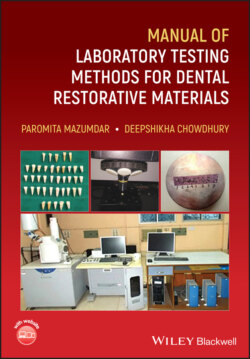Читать книгу Manual of Laboratory Testing Methods for Dental Restorative Materials - Paromita Mazumdar - Страница 19
1.6 Hardness
ОглавлениеMajor laboratory tests are performed to investigate products based on their bulk features. Hardness is not an intrinsic material property dictated by precise definitions in terms of fundamental units of mass, length and time. A hardness property value is the result of a defined measurement procedure. The hardness of a material gives an indication of the resistance to penetration when indented by a hard asperity. The value of hardness, often referred to as the hardness number, depends on the method used for its evaluation. Generally, low values of hardness number indicate a soft material and vice versa.
Hardness measurement can be defined as macro or micro, according to the forces applied and displacements obtained. Macro means large, therefore macro hardness is a measurement of the hardness of a material when a large force of greater than 50 N is applied. Macro hardness can be regular or superficial. In regular macro hardness, it is applicable to large area with deep penetration, whereas in superficial macro hardness, it is applicable to large area with shallow penetration. Macro hardness tests can be applied with heavier loads than micro indentation tests.
Micro hardness is a broadly used term referring to the testing of hardness involving materials by using small applied loads. A more appropriate term to describe this is micro indentation hardness testing. In this testing method, the use of a diamond indenter with a particular shape is used to make an impression called a “test load” or “applied force”, which can be at 1–1000 gf, on the material under testing. Normally, micro indentation tests involve 2 N forces, which are roughly equivalent to 200 gf. This force can produce an indentation of around 50 μm. Because of its specificity, this type of testing is applicable in cases where there is a need to watch for hardness changes on a microscopic level.
Rockwell, Brinell and Vickers hardness tests are applied for macro hardness testing, whereas Knoop hardness and Vickers hardness tests are done for microhardness testing.
Macro hardness testing has industrial applications such as testing hardness of steel, aluminium. Micro hardness test is applicable in dentistry for assessment of tooth samples and dental materials such as metals, ceramics and composites. Micro hardness tests are useful in giving required data when taking measurements of single microstructures situated within a bigger matrix and testing foil‐like or thin materials.
The usual method to achieve hardness value is to measure the depth or area of an indentation left by an indenter of a specific shape with a specific force applied for a specific time.
Vickers and Knoop both involve the use of diamond pyramid indenters. In the case of Vickers hardness, the diamond pyramid has a square base, whilst for Knoop hardness, one axis of the diamond pyramid is much larger than the other.
The Vickers hardness test method consists of indenting the test material with a diamond indenter, in the form of a right pyramid with a square base and an angle of 136° between opposite faces subjected to a load of 1–100 Kgf. The load is normally applied for 10–15 seconds. The two diagonals of the indentation left in the surface of the material after removal of the load are measured using a microscope and their average is calculated. The area of the sloping surface of the indentation is calculated. It is suitable to be applied to determine the hardness of small areas and for very hard materials.
Knoop hardness is more sensitive to surface characteristics of the material. The Knoop indenter is a diamond ground to pyramidal form that produces a diamond‐shaped indentation having approximate ratio between long and short diagonals of 7 : 1. The depth of indentation is about 1/30 of its length. When measuring the Knoop hardness, only the longest diagonal of the indentation is measured, and this is used in the following formula with the load used to calculate Knoop Hardness Number (KHN). Knoop hardness test is applied to evaluate enamel and dentine structures. One of the major difficulties is the requirement of a high polished flat surface that is more time‐consuming and more care taking compared to other tests.
Comparing the indentations made with Knoop and Vickers Diamond Pyramid indenters for a given load and test material, there are some technical differences as follows:
Vickers indenter penetrates about twice as deep as Knoop indenter.
Vickers indentation diagonal is about 1/3 of the length of Knoop major diagonal.Figure 1.12 Vickers hardness testing.Figure 1.13 Knoop hardness testing.Figure 1.14 Vickers hardness tester.
Vickers test is less sensitive to surface conditions than Knoop test.
Vickers test is more sensitive to measurement errors than Knoop test.
Vickers test is best for small rounded areas, whereas Knoop test is best for small elongated areas (as shown in Figures 1.12–1.14).
The Brinell hardness test method consists of indenting the material with a 10 mm diameter hardened steel or carbide ball subjected to a load. It is the oldest method to measure surface hardness and is applicable to test metals and alloys (as shown in Figure 1.15).
Measurements are normally made using a microscope since the indentations are often too small to be seen with the naked eye. The hardness is a function of the diameter of the circle for Brinell hardness and the distance across the diagonal axes for Vickers and Knoop hardness. Allowance is naturally made for the magnitude of the applied loads. In the case of Rockwell hardness, a direct measurement of the depth of penetration of a conical diamond indenter is made. The Rockwell hardness test method consists of indenting the test material with a diamond cone or hardened steel ball indenter. This method is useful to evaluate surface hardness of plastic materials used in dentistry [4] (as shown in Figure 1.16).
Figure 1.15 Brinell hardness testing.
Figure 1.16 Rockwell hardness testing.
Source: Vieira [4]. Licensed under CC BY 4.0.
